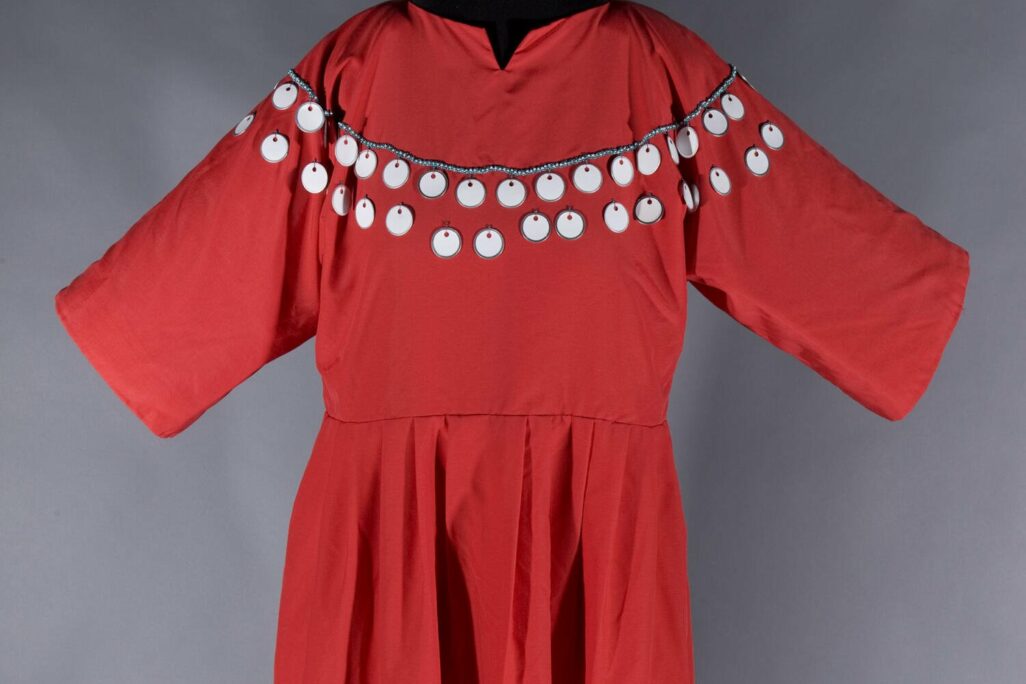Studio Sundays Online: Faye HeavyShield: Red Dress
About
This week for the MacKenzie’s online Studio Sunday, we are visiting artist Faye HeavyShield’s Red Dress, and how it relates to the social movement for remembering Missing and Murdered Indigenous Women and Girls. In response, create your own symbol to help raise awareness for a social movement you care about. This program is connected to The Art of Faye HeavyShield.
About the Artwork
Have you ever thought about artworks as living things? In many Indigenous cultures, artworks are thought of as alive. These living artworks have important roles in everyday life. They also hold and pass on cultural knowledge.
Faye HeavyShield sees artworks as living beings. It upsets her to see Indigenous artworks stored in museum and gallery vaults away from the cultures they are part of. “I speak Blackfoot to them [Indigenous artworks in museums] so they can listen because they probably have not heard Blackfoot in a long time and are housed far away from their communities,” she says.
Faye created Red Dress as a response to seeing Indigenous artworks in storage at galleries and museums. It looks like an outfit that a Blackfoot woman might wear. However, it has a row of blank museum tags dangling across the collar of the dress where beads made of shell or elk teeth might normally be sewn.
This artwork uses symbols to speak with viewers. The blank museum tags symbolize all the living artworks that are being kept in museums and galleries. Many Indigenous artworks are kept in museums without a record of who the artist is, where the artwork is from, and what it’s meaning and purpose might be. Many of these stored artworks were created by women, whose work and knowledge are often treated as less important in colonial cultures. The red dress has also become a symbol for missing and murdered Indigenous women, girls, and two-spirit people. Red Dress is inviting us to think about the artworks in museums as missing people.
About the Artist
Faye HeavyShield is part of the Kainai (Blood) Nation, which is a member of the Blackfoot Confederacy. She was born in 1953 on the Kainai (Blood) Reserve. Faye grew up learning the Blackfoot language and her family’s traditional ways of life. She also attended a Catholic residential school during her childhood.
Faye’s artworks tell many powerful and layered stories. These include her personal stories, stories from her Indigenous community and of Blackfoot women, and stories of colonization on the Canadian prairies. Many of her artworks have a strong connection to prairie and coulee landscapes and the forces of nature.
Faye is known for her unique and poetic art language. Her work is quite minimalist; each artwork uses a small number of colours, shapes and symbols to thoughtfully speak to people. Many of Faye’s artworks are installations. Installation art is like creating an environment for the viewer to be in or interact with.
Faye HeavyShield’s artworks are an important part of contemporary (current) Indigenous art and culture.
- A symbol in visual art is an image that stands for a bigger idea. For example, when you see a red cross, you might think about health care, hospitals, or the Red Cross organization that gives emergency health care around the world. Symbols are part of the language of visual art. What symbols can you think of that anyone would recognize? What symbols can you think of that only specific people would know?
- Are there any artworks that are part of your everyday life? Have you ever thought about these artworks as alive?
Studio Activity
In response to Faye HeavyShield’s Red Dress, create your own symbol to help raise awareness for a social movement you care about.
In response to Faye HeavyShield’s Red Dress, create your own visual symbol to help raise awareness for a social issue you care about.
Supplies:
- Scrap paper
- Pencils, erasers, and sharpeners
- Vinyl or sticker paper
- Markers or sharpies
- Scissors
Instructions:
- Think about a social issue that matters to you. This could be something that’s happening in the world that you believe is unfair. It could be a change you would like to see in how people act or think.
- On a scrap paper, draw some symbols that could represent this social issue. Think about shapes and colours that people would recognize easily and connect with your social issue. Try to make your symbol bold and easy to see and understand. You might want to test out your symbols by showing them to a friend or family member. Ask that person what they think about when they see the symbols.
- Choose a colour of vinyl or sticker paper that adds to the meaning of your symbol. Draw your symbol onto the vinyl or sticker paper. If you are drawing on the slippery side of vinyl, you may need to use a sharpie marker. Or, you can use a regular marker or pencil on the back of the vinyl/sticker paper. Just don’t forget that if you draw on the back of the page, your symbol will be flipped around on the front!
- Cut out your symbol to create a shaped sticker.
- If you thought of more than one symbol, you could draw and cut them out as well from different colours of sticker paper. You could connect these stickers together, or add smaller symbols on top of a bigger symbol.
- Find somewhere to put your sticker where people will see it. Talk with friends and family when they see your sticker. Were they able to tell what your symbols stood for? Did they know that this was a social issue you cared about? Are you able to help them learn something about this issue?
Extension:
Think about ways you could use the image you’ve created other than as a sticker! What other ways are images shared to help raise awareness about issues?

